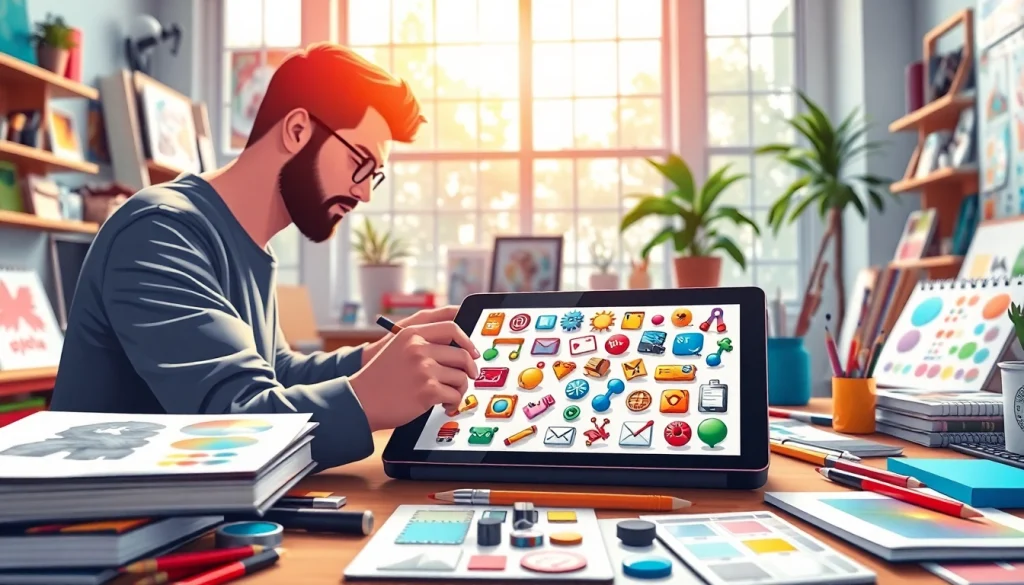Icons have become an integral part of modern digital design, serving as universal visual cues that enhance user experience and interface functionality. In exploring the world of icons, we delve deeply into their significance, design principles, implementation strategies, and the various resources available for acquiring them. This article aims to provide readers with a comprehensive understanding of icons, from their basic definitions to their effective utilization in digital projects and evaluation metrics for success.
Understanding Icons: The Basics and Importance
What Are Icons?
Icons are small graphical representations that symbolize actions, concepts, or objects in a visual language understood across different cultures and languages. These symbols serve to convey messages quickly and effectively, reducing the cognitive load on users by providing intuitive shortcuts to complex ideas or actions.
Historically, icons have roots in art and religion, but in contemporary design, they are primarily digital assets employed in user interfaces, websites, applications, and various forms of media. Icons can take different forms, including but not limited to vector graphics, bitmap images, and animated elements.
The Role of Icons in Design
Icons play a pivotal role in enhancing the user experience (UX) within digital interfaces. They do this by:
- Simplifying Communication: By visually representing functions or content, icons make navigation easier and more understandable for users.
- Creating Visual Hierarchy: Icons help distinguish various elements on a page, guiding users through content and interactions.
- Enhancing Aesthetics: Well-designed icons contribute to the overall visual appeal of a website or application, making it more engaging.
- Improving Accessibility: Icons can aid users with various needs, offering visual cues that complement textual information.
Types of Icons: A Quick Overview
Understanding the different types of icons is crucial for effective design. Here’s a brief overview of the most common types:
- Action Icons: Represent specific actions like editing, deleting, or downloading.
- Navigation Icons: Facilitate movement within an interface, such as arrows or home buttons.
- Social Media Icons: Connect to various social platforms and are often used for sharing content.
- File Type Icons: Indicate different file formats, assisting users in identifying how to interact with files.
Creating Custom Icons: Tools and Techniques
Essential Software for Icon Design
Designing custom icons requires the right tools. Here are some of the most essential software programs that can help streamline the icon creation process:
- Adobe Illustrator: A powerful vector graphic editor favored by professionals for its comprehensive features and precision.
- Sketch: Popular among UI designers, Sketch offers a user-friendly interface tailored for web and mobile design.
- Figma: A collaborative design tool that allows multiple users to work on a project in real-time, ideal for teams.
- Inkscape: An open-source vector graphics editor that is a great alternative for those who prefer free software.
Best Practices for Drawing Icons
To create effective icons, certain best practices should be followed:
- Simplicity is Key: Icons should be simple and easily recognizable. Overly complex designs can confuse users.
- Maintain Consistency: Use a consistent style and size across all icons to ensure a cohesive visual language.
- Use Metaphors: Choose symbols that resonate with users; metaphorical representations can enhance functionality and understanding.
- Color and Contrast: Use colors that align with your overall design scheme while ensuring icons stand out against their backgrounds.
Exploring Styles: Minimalist to Illustrative Icons
Icons can be crafted in various styles, each serving a different aesthetic and functional purpose. Here’s an overview:
- Minimalist: Focuses on simplicity, often using geometric shapes and a limited color palette for clarity.
- Illustrative: Offers more detail and creativity, often representing concepts in a unique, artistic way.
- Flat Icons: Characterized by clean lines and a lack of depth, flat icons work well in modern design.
- 3D Icons: Provide depth and dimension, suitable for applications requiring a more engaging look.
Incorporating Icons in Digital Projects
Using Icons for User Experience Improvement
Strategically incorporating icons into web and app designs enhances user experience. Here are some methods:
- Guided Navigation: Icons can indicate navigation paths, making it intuitive for users to explore content.
- Action Indicators: Use icons to highlight calls to action, increasing user engagement.
- Visual Breaks: Icons provide breaks in content, helping to maintain user interest and preventing fatigue.
Icon Placement Strategies in Web Design
Proper placement of icons in a design layout is crucial. Consider the following strategies:
- Proximity: Place icons close to the content they represent to enhance clarity.
- Above the Fold: Position critical icons, such as navigation or call-to-action buttons, where they are easily visible without scrolling.
- Consistency: Ensure a uniform placement of icons across all pages to aid familiarity.
Responsive Design: Ensuring Accessibility of Icons
Incorporating icons into responsive designs is essential for mobile compatibility. Here are important considerations:
- Scalability: Ensure icons are scalable so they appear sharp on various screen sizes.
- Touch Targets: Icons should be large enough for easy tapping on touchscreens.
- Test Across Devices: Regularly test icons on multiple devices and resolutions to ensure usability.
Finding the Right Icons for Your Needs
Top Resources for Downloading Icons
Various platforms offer extensive libraries of icons. Here are some top resources:
- Flaticon: Features over 18 million icons in different formats, making it one of the largest icon databases.
- Icons8: Provides a vast assortment of icons categorized for easy browsing, with options for customization.
- Noun Project: Known for a wide range of icons contributed by designers worldwide.
- Iconfinder: A marketplace for both free and premium icons.
Choosing Between Free and Premium Icons
When selecting icons, consider the following factors:
- Quality: Premium icons often offer superior design quality and uniqueness.
- Licensing: Check usage rights; some free icons may require attribution, while premium icons usually come with more flexible licensing.
- Support: Premium options might offer better customer support and updates.
Understanding Licensing and Usage Rights
It’s essential to understand licensing terms associated with icons to avoid legal issues:
- Royalty-Free: You pay once and can use the icon as many times as you’d like.
- Attribution Required: Some free icons require credit to the creator, which can be a design consideration.
- Exclusive Licenses: Premium icons often come with rights that protect against others using the same design.
Evaluating Icon Efficiency and Performance
Analyzing User Interaction with Icons
Understanding how users interact with icons is crucial for improving their design. Here are analytical methods:
- Heatmaps: Use tools like Hotjar or Crazy Egg to visualize where users click most frequently.
- User Feedback: Regularly collect feedback on the clarity and usability of icons.
- Click-Through Rates (CTR): Monitor how often users engage with calls to action and adjust icon designs accordingly.
Conducting A/B Testing for Icon Effectiveness
A/B testing involves comparing two versions of a design to determine which performs better. Implement these steps:
- Define Key Performance Indicators (KPIs): Identify what metrics will signify success, such as CTR or user satisfaction.
- Create Variants: Develop two versions of an interface – one with the original icons and one with new designs.
- Analyze Results: Collect data on user interactions to identify which icon set performed better.
Metrics for Successful Icon Design Implementation
To measure the success of icon integration, consider the following metrics:
- User Retention Rates: High retention often indicates effective navigation and usability.
- Conversion Rates: Analyze whether the use of icons correlates with an increase in completed actions (purchases, sign-ups, etc.).
- Time on Task: Measure how long it takes users to complete actions; efficient icons should streamline these processes.





